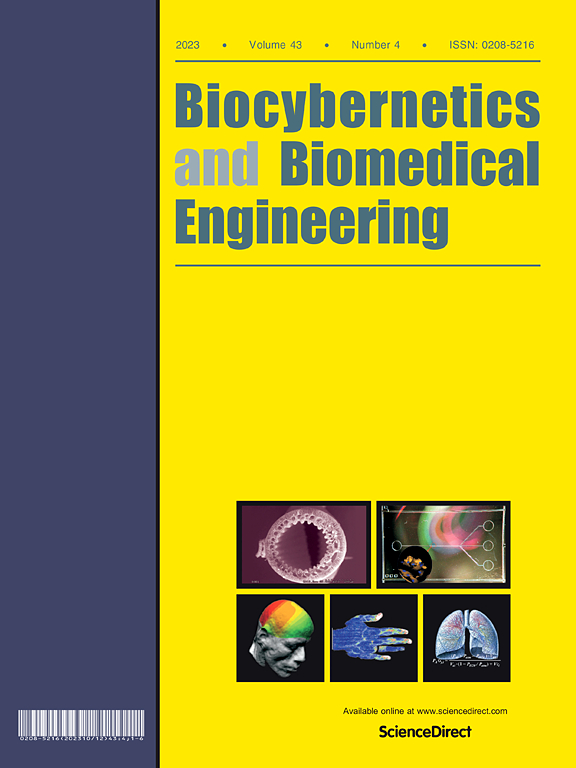基于码调制视觉诱发电位的混合现实与脑机接口集成研究
IF 6.6
2区 医学
Q1 ENGINEERING, BIOMEDICAL
引用次数: 0
摘要
背景和目的:脑机接口(BCI)系统可以帮助患有严重运动障碍的人,通过使用拼写器使他们的大脑信号能够交流,从而允许从一组选项中选择命令。对于这项技术,准确性、速度和用户舒适度是必不可少的。编码调制视觉诱发电位(c-VEPs)在脑机接口控制中表现出良好的性能。将BCI系统与混合现实(MR)集成可以提供可移植性和自主性。然而,据我们所知,目前还没有研究探讨MR与基于c- vep的脑机接口联合的可行性。本研究旨在:(1)评价MR与基于c- vep的脑机接口集成的性能;(2)研究与传统屏幕相比,c- vep引起的视觉疲劳。方法:20名参与者使用36个字符的拼写器在MR和传统屏幕条件下选择单词。测量了准确性和信息传输率(ITR)等指标。通过问卷对可用性和眼疲劳进行评价。结果:MR与c-VEPs的整合准确率为96.71%,ITR为27.55 bits/min,而常规筛选条件下准确率为95.98%,ITR为27.10 bits/min。调查问卷显示,在两种情况下,视觉疲劳的程度都很低,可用性也很高。在表现或视觉疲劳方面,没有观察到明显的差异。结论:基于c- vep的拼写器与MR-BCI技术被证明是可行的,在两种情况下都具有较高的准确率,达到了与传统设置相似的性能水平。该研究还发现MR和传统屏幕的视觉疲劳程度相当,这支持了MR集成在脑机接口系统中的实用性。本文章由计算机程序翻译,如有差异,请以英文原文为准。
Toward the integration of mixed reality and brain-computer interfaces based on code-modulated visual evoked potentials
Background and objective: Brain-computer interface (BCI) systems can assist individuals with severe motor disabilities by enabling communication through their brain signals using spellers, which allow selecting commands from a set of options. For this technology, accuracy, speed and user comfort are essential. Code-modulated visual evoked potentials (c-VEPs) have demonstrated promising performance in BCI control. Integrating BCI systems with mixed reality (MR) could provide portability and autonomy. However, to the best of our knowledge, no existing studies have explored the feasibility of combining MR with c-VEP-based BCIs. This study aims to: (1) evaluate the performance of integrating MR with c-VEP-based BCIs and (2) study the visual fatigue induced by c-VEPs compared to traditional screen. Methods: Twenty participants used a 36-character speller to select words in both MR and traditional screen conditions. Metrics like accuracy and information transfer rate (ITR) were measured. Usability and eyestrain were evaluated through questionnaires. Results: The integration of MR with c-VEPs achieved an accuracy of 96.71 % and an ITR of 27.55 bits/min, compared to 95.98 % accuracy and 27.10 bits/min for the conventional screen condition. The questionnaires revealed minimal levels of visual fatigue in both conditions and high usability. No significant differences were observed between conditions in terms of performance or visual fatigue. Conclusions: The c-VEP-based speller with MR-BCI technology proved feasible, achieving performance levels similar to the conventional setup, with high accuracy in both conditions. The study also found comparable visual fatigue between MR and traditional screens, supporting the practicality of MR integration in BCI systems.
求助全文
通过发布文献求助,成功后即可免费获取论文全文。
去求助
来源期刊

Biocybernetics and Biomedical Engineering
ENGINEERING, BIOMEDICAL-
CiteScore
16.50
自引率
6.20%
发文量
77
审稿时长
38 days
期刊介绍:
Biocybernetics and Biomedical Engineering is a quarterly journal, founded in 1981, devoted to publishing the results of original, innovative and creative research investigations in the field of Biocybernetics and biomedical engineering, which bridges mathematical, physical, chemical and engineering methods and technology to analyse physiological processes in living organisms as well as to develop methods, devices and systems used in biology and medicine, mainly in medical diagnosis, monitoring systems and therapy. The Journal''s mission is to advance scientific discovery into new or improved standards of care, and promotion a wide-ranging exchange between science and its application to humans.
 求助内容:
求助内容: 应助结果提醒方式:
应助结果提醒方式:


